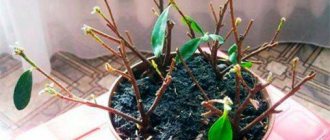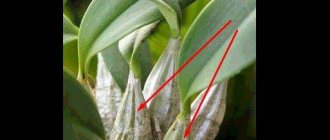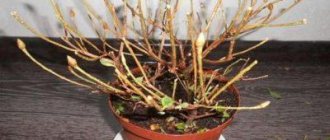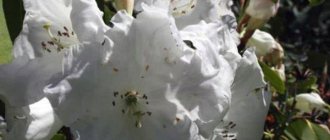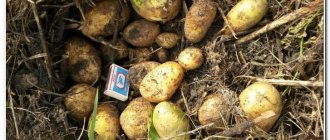Detailed description
In terms of its decorative properties, Indian azalea is superior to many indoor plants. It is distinguished by long and lush flowering, as well as a variety of bud colors - from white to bright red.
Azalea inflorescences are large and can reach 7 cm in diameter; the petals can have double or corrugated edges. There are usually 5-6 flowers in the leaf axils. The plant can grow up to 50 cm in height.
History of origin
Azalea indica is considered the main ancestor of indoor rhododendron varieties, from which other hybrids were obtained. Azalea was brought to Europe in the 16th century from China and Japan. By the 20th century, there were more than a thousand varieties of rhododendrons in cultivation.
Specifically, the Indian azalea was obtained as a result of interspecific and hybrid crossings of rhododendron simsa. The Indian azalea came to Russia as a gift to the royal family and was initially kept exclusively in court greenhouses.
Varieties - description and photo
Mix
Azalea Mix has small dark green leaves and large inflorescences in red, yellow, white, cream and pink. There is a heterogeneous color of flowers. The central shoot can reach 50 cm in height. The plant is quite finicky in terms of care, which, however, does not stop gardeners from actively breeding it.
For Indian azalea mix, the composition of the soil is of paramount importance - when planting, acidic soil with a high content of organic elements is used.
Bicolor (pink)
Azalea Bicolor is one of the most vibrant varieties of rhododendrons . The height of the plant can reach 0.5 m. The inflorescences of the Indian azalea are medium-sized and pink in color, and the leaves are dark green.
White
White Indian azalea occurs in several varieties:
- Apollo;
- saculanta;
- weise sheme.
The inflorescences of white azalea are quite large, can reach 7 cm in diameter. The petals of the flowers are white and slightly light green at the base.
Red
The flowers of red azalea are double and reach a diameter of approximately 6 - 6.5 cm, and the leaves are dark green. A bright red plant can be grown if you plant Knut Erwen.
Flamenco
This variety of azalea assumes the presence of double inflorescences that have a neat white-pink color. The duration of flowering is from the beginning of autumn to the end of April. The plant is distinguished by the abundance and brightness of its flowers.
Simsa
Sims blooms in the winter-spring period. The color range of inflorescences is varied - from white to red. The size of the buds reaches 3-5 cm, the petals of the plant are forked and have terry or grooved edges.
Helmut
Indian azalea helmut differs from other types of azaleas by its rather bright double inflorescences of purple-red color, the diameter of which can reach about 6 cm.
In our articles you can learn about types of azaleas, including Bloombux, as well as about growing them as bonsai.
Indian rhododendron blooming
When and how does it happen?
Active flowering of Indian azalea occurs in the winter-spring period. It begins to bloom in December and can delight with bright flowers until May. A prerequisite for rapid flowering are the swelling buds that form on the stems of the plant.
How to care?
In order to ensure the most luxuriant flowering of Indian azaleas, it will be useful to perform pinching, which involves removing young shoots. This should be done so that the plant concentrates its energy on the blooming buds, and not on new shoots.
After flowering, you should carefully remove all dried buds.
What to do if it doesn't produce flowers?
Several factors can affect the lack of flowering in Indian azaleas:
- unsuitable soil for the plant;
- lack of nutrients;
- excessively high temperature, preventing the formation of buds.
It is very important to ensure that the plant is in conditions that are comfortable for it.
Azalea indica - capricious, but so beautiful!
Capricious, incredibly beautiful, difficult to care for - all these words can be attributed to a plant called azalea indica . And don’t let the difficulties in care scare novice flower growers - the azalea will repay you for your due attention with lush, spectacular flowering.
So, you have an indica azalea in your home and many questions immediately arise about caring for this plant.
It is enough to know a few features of this flower and then it will remain in your home for many years.
Step-by-step instructions for care at home
Choosing a landing site
It is extremely harmful for Indian azaleas to be in direct sunlight . It is important that during flowering the plant is in partial shade, in diffused light and in free space. The best option for a flower would be a window sill located on the western, eastern or northern side.
What should the soil be like?
The soil for Indian azalea should have a pronounced acidic reaction. The following proportions are optimal:
- coniferous land - 2 parts;
- coarse sand – 1 part;
- peat – 1 part.
Properly selected soil will ensure active growth and proper development of the plant.
How to plant?
The container in which you plan to plant the plant must have drainage holes. The Indian azalea pot should be wide enough, but not too deep. The bottom of the flower pot is lined with a drainage layer that includes small pebbles or expanded clay.
Temperature
The optimal temperature regime for Indian azalea is about 15-18 degrees in autumn and winter. In summer it can be 22 degrees. During the period of active flowering, the temperature should be lowered to 10-12 degrees.
Watering
The soil in a pot with Indian azalea should be moderately moist. It is important to avoid overwatering. Azaleas should be watered and sprayed only with soft water that does not contain chlorine and lime. From time to time, you can slightly acidify the water for irrigation with peat or a couple of drops of table vinegar.
Excessive dampness in a pot of Indian azalea leads to wilting of the leaves and subsequently to the death of the plant.
Top dressing
Azaleas are typically fed twice a month from late February to late August. This helps them both with growth and with the formation of buds. It would be best to use specialized fertilizers designed specifically for rhododendrons (azaleas). It is also possible to fertilize with any chlorine-free fertilizers used for Saintpaulias and hydrangeas.
For leaf chlorosis, fertilizers that contain iron and magnesium are best suited.
Trimming
Pruning should be done after flowering in order to form a crown in the form of a tree or bush. It is necessary to remove shoots that are too long and weak and prune young branches to ensure more luxuriant flowering for the plant.
Transfer
Indian azalea reacts extremely painfully to damage to the root system. When replanting, it is better not to disturb the roots again, which is why it is preferable to transship them to preserve their integrity. Pots should not be very deep, since azalea has a superficial root system. Young plants are subject to annual replanting, depending on their growth, adults – once every 2-3 years.
When transplanting, drainage is placed at the bottom of the pot. The soil used is strongly acidic, intended for rhododendrons (azaleas).
It will be useful to place pieces of sphagnum moss on the surface of the soil.
How to propagate?
There are several methods of reproduction, such as:
- using seeds;
- cuttings;
- vaccination;
- dividing the bushes (as a rule, an old plant with a large number of shoots is used).
Breeding azaleas using seeds is not effective; this method is rarely used. A more effective method is to propagate azaleas using cuttings. The process consists of several stages:
- Choice of cuttings. The cuttings should be 5-7 months old. Remove the buds, leave 3-4 leaves at the top. The length of the cutting is 6-7 cm.
- Preparing the cuttings. Treat with a non-concentrated solution of potassium permanganate.
- Preparing the landing site. Pebbles are laid out at the bottom of the container and soil on top. Water the soil well before planting.
- Landing in the ground. Plant 3-4 pieces in a pot, planted in abundantly watered soil at a distance of 4-5 cm from each other. Planting depth 2-3 cm.
- Creating conditions for growth. Cover the cuttings with film, moisten the soil from time to time and ventilate the cuttings daily. Such breeding is labor-intensive, but produces significant results.
2 Propagation by cuttings - what's what?
At home, flower growers often resort to breeding azaleas from cuttings. The procedure should be started in spring or summer. Successful rooting can be ensured by using acidic nutrient soil. It is necessary to cut cuttings 8-9 cm long. All leaves are removed from the lower area of the shoot, and half foliage is left in the upper area. An oblique cut is made under a bud or under a cluster of leaves. It is not recommended to take cuttings from all plants. Select the healthiest flowers that have already shown full bloom. Cut one shoot from it, but it is important to do this no more than once during the whole year.
The rooting process will be better if you place all the cuttings in a Heteroauxin solution. A couple of tablets of the substance should be diluted in 1 liter of water. Tie all the cut shoots together (1-15 pieces each) and place them in fertilizer for 5-6 hours. You can also use Kornevin or Zircon. The treated branches are planted in small greenhouses, containers or bowls. The shoot should go into the nutrient soil to a depth of 4-5 cm, the distance between them can be at least 4 cm.
The soil is laid out in the selected container as follows. The bottom of the vessel is covered with a drainage layer of 2-3 cm. Expanded clay or gravel is used as drainage, and fragments of broken dishes are occasionally placed. Then add 3 cm of sand and fill the container with peat and pine soil. Vermiculite is often used for planting cuttings. In such soil the plant can get comfortable even better.
After planting is completed, the shoots should be covered with plastic film or glass. Subsequent actions boil down to regular watering. If planting and maintenance conditions are met, the cuttings will take root within 1.5-2 months. In this case, the air temperature should be +25 degrees, and the air humidity should be at least 80%. The soil in which flowers grow must be warm. Sometimes heating it is practiced.
Caring for indoor azalea cuttings includes regular morning airing. Raise the cover every day for about 30-40 minutes so that the plants can get a dose of oxygen. Don’t forget to monitor the lighting: rotate the box with the shoots, so the sunlight will evenly cover all the seedlings. With the appearance of the first roots and the beginning of growth, remove the film (or glass) from the plant. At this stage, it needs maximum hydration. Water and spray the cuttings, making sure that the soil is constantly moist. If all instructions are followed, cuttings of azaleas will give 90% results.
When the shoots grow 2-3 cm, they can be transplanted into other containers. Coniferous soil is used for planting. In December, after picking, gardeners advise pinching the apical branches of young flowers. Thanks to this, young shoots are formed, and the bush will form thicker and more branched. The first buds are removed to stimulate shoot growth.
In March, a second pinching should be done, cutting off 5-6 azalea branches. At the end of all procedures, the young plant is transplanted into flower pots with a diameter of 10-11 cm. The bottom of the pot is covered with drainage and filled with a mixture of peat and coniferous soil. In the future, water the flowers with water at room temperature. After 3 years, grown azaleas can be cut again.
Reproduction methods
Propagating Indian azaleas at home is not the easiest task. Rooting lasts at least 1.5-2 months.
- The length of the cuttings should be about 5-6 cm. Cuttings should be cut in March-June from shoots that have not yet become woody.
- Before planting, the cuttings must be washed in a pale pink solution of potassium permanganate, then treated with any root formation stimulator.
- The container with the plant is covered on top with a plastic bag or glass jar and placed in a fairly warm, dimly lit place.
- Azaleas should be watered only with warm water.
- After some time, the cutting begins to grow, then the container is moved to a more illuminated place, but avoiding direct sunlight.
- Young seedlings require hardening, so the film or glass cover is raised daily.
Indian azalea is distinguished by its bright and lush flowering, thanks to which it will serve as the main decoration of the home garden. In order for the plant to delight with bright flowers for a long time, it is important to provide it with proper and attentive care.
If you find an error, please select a piece of text and press Ctrl+Enter.
Azalea Indica home care
If all care conditions are met, the azalea will reward you with lush, attractive flowering.
Temperature readings
The plant loves colder air. The optimal criteria are numbers from +10 0 C to +15 0 C. If during winter such conditions are easy to create, then in summer everything is much more difficult. Many gardeners move the flowerpot to a cool room or dig it into the ground. In this case, it is worth closing the container to prevent insects from getting inside. To do this, a nylon stocking is pulled over the flowerpot.
In autumn, it is recommended to take the flower out onto the loggia or into a cold room. This will help the plant to lay a considerable number of buds, which will delight you with bright colors closer to spring.
Drip irrigation system and air humidity
Azalea is a flower that loves wet soil. Thus, in order for the bush to be attractive and develop well, it is necessary to regularly monitor the condition of the soil. The plant should be watered only with settled liquid without any impurities.
Azalea does not tolerate stagnation of liquid.
In the cold season, it is recommended to reduce the number of procedures by half and stop spraying.
Any water that has collected in the pan must be poured out regularly. This will help eliminate rotting of the root system. It is recommended to acidify the liquid once a month. To do this, use citric or oxalic acid. Add it at the rate of 0.3 g per 1 liter of drinking water, at home temperature.
Pruning and pinching bushes
This procedure is considered mandatory, as it increases the intensity of azalea flowering. The first procedure is carried out in May immediately after flowering. At the same time, all weak, limp and deformed branches are cut off.
If you do not prune and pinch, then after a certain time the bushes will become looser and the flowers will become very small.
During the summer period, all young shoots must be pinched, and elongated shoots must be trimmed. Each branch should have 4-5 leaves.
Also be sure to pinch the shoots that appear near the flower axils. If everything is done correctly, new branches will appear in 2-3 weeks.
Diseases and pests
The plant is quite resistant to disease, but if you bypass the rules of care, the leaves can be attacked by various insects. Very often, scale insects, flower moths, whiteflies, mealybugs, and aphids are observed on azaleas. Spider mites and thrips also feed on Indica leaves.
